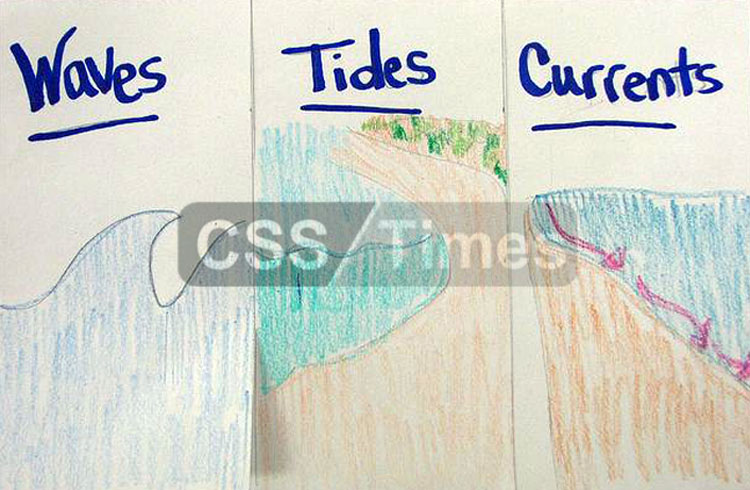Waves – Tides & Current
CSS General Science Notes
Waves
The winds cause waves on the surface of the ocean (and on lakes). The wind transfers some of its energy to the water, through friction between the air molecules and the water molecules. Stronger winds (like storm surges) cause larger waves.
Tides
Tides are periodic rises and falls of large bodies of water. Tides are caused by the gravitational interaction between the Earth and the Moon. The gravitational attraction of the moon causes the oceans to bulge out in the direction of the moon. Another bulge occurs on the opposite side, since the Earth is also being pulled toward the moon (and away from the water on the far side). Since the earth is rotating while this is happening, two tides occur each day. Isaac Newton was the first person to explain tides scientifically.
The Sun’s Interaction with the Tides
Spring tides are especially strong tides (they do not have anything to do with the season spring). They occur when the Earth, the Sun, and the Moon are in a line. The gravitational forces of the Moon and the Sun both contribute to the tides. Spring tides occur during the full moon and the new moon.
The Proxigean Spring Tide is a rare, unusually high tide. This very high tide occurs when the moon is both unusually close to the Earth (at its closest perigee, called the proxigee) and in the New Moon phase (when the Moon is between the Sun and the Earth). The proxigean spring tide occurs at most once every 1.5 years.
Check Also: General Science MCQs
Neap tides are especially weak tides. They occur when the gravitational forces of the Moon and the Sun are perpendicular to one another (with respect to the Earth). Neap tides occur during quarter moons.
An Ocean Current
An ocean current is a continuous, directed movement of ocean water generated by the forces acting upon this mean flow. Such as breaking waves, wind, Coriolis effect, cabbeling, temperature and salinity differences and tides caused by the gravitational pull of the Moon and the Sun
Check Also: Science Myths Exposed: Unraveling the Truth Behind Them
Ocean currents can flow for great distances, and together they create the great flow of the global conveyor belt which plays a dominant part in determining the climate of many of the Earth’s regions. Perhaps the most striking example is the Gulf Stream, which makes northwest Europe much more temperate than any other region at the same latitude. Another example is Lima, Peru, where the climate is cooler (sub-tropical) than the tropical latitudes in which the area is located, due to the effect of the Humboldt Current.
Check Other NOTES for General Science & Ability
- What is An Avalanche? | General Science & Ability CSS Notes
- Waves – Tides & Current | CSS General Science Notes
- What is Tsunami? Their Generated & Characteristics | CSS General Science & Ability Notes
- Volcanoes | CSS General Science & Ability Notes
- What is Earthquake? | General Science & Ability Notes
- The Solar System | General Science & Ability Notes for CSS







